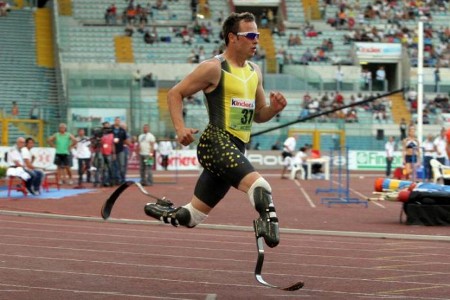
Link: http://www.time.com/time/magazine/article/0,9171,1704675,00.html
It was only a matter of time before the challenge of Oscar Pistorius would run headlong into our cherished notions of what's equal, what's fair and what's the difference between the two.
Democracy presumes that we're all created equal; competition proves we are not, or else every race would end in a tie. We talk about a level playing field because it's the least we can do in the face of nature's injustice. Some people are born strong or stretchy, or with a tungsten will. But Pistorius' advantage comes from what nature left out and technology replaced: his body ends at the knees, and from there to the ground it's a moral puzzle.
Born in South Africa without major bones in his legs and feet, he had his lower legs amputated before he was a year old. As he grew up, so did the science of prosthetics. Now 21, Pistorius runs on carbon-fiber blades known as Cheetahs. He won gold in the 200 m at the Athens Paralympics in 2004, breaking 22 sec.; but now his eye is on the Olympics in Beijing. It was up to the world body that governs track and field, the International Association of Athletics Federations (IAAF), to determine whether using Cheetahs is cheating.
A runner's stride is not perfectly efficient. Ankles waste energy—much more, it turns out, than Pistorius' J-shaped blades. He can run just as fast using less oxygen than his competitors (one describes the sound Pistorius makes as like being chased by a giant pair of scissors). On Jan. 14, following the findings of the researcher who evaluated him, the IAAF disqualified Pistorius from Olympic competition. He is expected to appeal, arguing that the science of advantage is not that simple. Tom Hanks is interested in his life story. No matter what happens next, Pistorius is changing the nature of the games we play.
Our intuition tells us there's a difference between innate advantages and acquired ones. A swimmer born with webbed hands might have an edge, but a swimmer who had skin grafts to turn feet into flippers would pose a problem. Elite sport is unkind to the human body; high school linemen bulk up to an extent that may help the team but wreck their knees. What about the tall girl who wants her doctor to prescribe human growth hormone because her coach said three more inches of height would guarantee her that volleyball scholarship: Unfair, or just unwise? Where exactly is the boundary between dedication and deformity?
Imagine if Pistorius' blades made him exactly as biomechanically efficient as a normal runner. What should be the baseline: Normal for the average man? Or for the average Olympian? Cyclist Lance Armstrong was born with a heart and lungs that can make a mountain feel flat; he also trained harder than anyone on the planet. Where's the unfair advantage? George Eyser's wooden leg didn't stop him from winning six Olympic gymnastics medals, including in the parallel bars. But that was 1904; legs have improved since then.
The questions are worth asking because in them lies not just the future of our sports but of ourselves. Why should nature be allowed to play favorites but not parents? Science will soon deliver unto us all sorts of novel ways of redesigning our offspring or re-engineering ourselves that test what we mean by human. The fight over doping in baseball will seem quaint one day when players can dope not with drugs but with genes. Already there is black-market interest in therapies developed to treat muscular dystrophy but which could potentially be used to build superstrong athletes.
But there is no honor in shortcuts. Today's dopers are like Rosie Ruiz's winning the marathon in 1980—because she took the subway. Are Pistorius' blades the equivalent of his attaching wheels to his running shoes? "We end up with these subtle, fascinating debates about what the meaning of competition is, and endless debate over where to draw the line," says Tom Murray, president of the Hastings Center, a bioethics think tank. "Don't underestimate how difficult it will be to evaluate all the technologies that are likely to filter into sport."
We honor heroes—in sports as in life—for grace and guts as well as natural gifts. When something comes easily, it's easy not to work at it, like the bright kid who coasts through class: talent taps persistence on the shoulder, says, You're not needed here. But put the two together, Tiger Woods' easy power and ferocious discipline—and he makes history. There's some sweet irony in the fact that before Pistorius came along, there was no need for the rules that now ban him. Only when the disabled runner challenged the able-bodied ones did officials institute a rule against springs and wheels and any artificial aids to running. That's a testimony to technology, but it is also a tribute to the sheer nerve and fierce will that got him to the starting line in the first place.
No comments:
Post a Comment